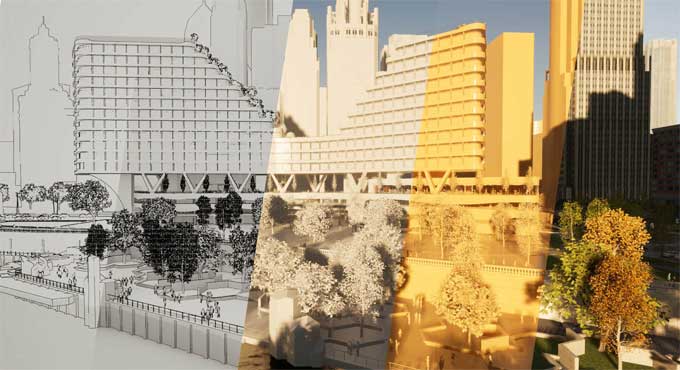VR and AR Simulations in Architectural Design by AEC Companies

Virtual reality and augmented reality have existed for decades, but the original adoption was slow and limited to the gaming industry. During the past few years, this technology has gained popularity among architects. There is an aggressive race between tech companies to introduce practical applications to the field of architecture and engineering.
As the design process, building maintenance, and energy consumption of buildings improve, the architecture, engineering, and construction industry constantly develops and adopts new technologies. Aside from all recent adoptions, virtual reality and augmented reality have the greatest potential to impact the upcoming years. It is clear that visualization and interactivity offer architects a better way to present their designs to clients and build their business.
AEC Company Adoption
In the AEC industry, for instance, VR or AR can differentiate between internal communication processes within the team and external communication with clients. In the internal review process, architects, engineering consultants, contractors, and subcontractors use the models. Whenever collaboration with external parties is required, they can access the same models.
The models are meant to bridge communication between the team and their clients, including end users and funding institutions. Models from a project might differ in details, particularly in their annotations, despite being part of the same project.
Marketing
It is common for real estate developers to begin their projects without knowing who their buyers are. Virtual reality is another type of visualization, even though it's more sophisticated than static and animated renders. Using only a plan to market a property reduces the financial risk for every developer.
Using online platforms, including social media or video sharing sites, developers can make VR gear more accessible now that it is no longer an expensive exclusive.
In VR models, the building should see and feel like it look and feel once the construction is completed. A model with interactive features should give it an edge over competition still using static analysis renderings. In addition to improving online exposure, a broader pool of potential buyers is more likely to be reached.
Hidden Visualization
Using VR models within the AEC industry involves various priorities and approaches. Usually, users create a virtual world that resembles a real world environment with the aim of visualizing it. Architectural visualization aims to achieve this goal for many people.
However, there is another functionality that has been relatively underexplored. Within the virtual world, technicalities that are otherwise invisible can be observed. As VR technology advances, it will soon be able to visualize abstract matters such as wind speed, light intensity, or direction.
Portfolio
By using VR models to showcase their engineering experience and expertise, architectural firms will be able to showcase their expertise. The 3D VR models may not always guarantee victory, but they are a great way to showcase proficiency in the finer details.
VR is a step ahead of static and animated renders in terms of sophistication, not only in terms of aesthetics but also in terms of how the visualization allows close examination. By completing a project to the highest standard, it becomes a testament to the firm's thoroughness, attention to detail, and willingness to go the extra mile.
Risk Avoidance
Large companies incorporate VR primarily for risk avoidance purposes. Profits from big-budget projects are likely, but they can also be a source of losses as well. A VR tool can be used by established firms to visualize and learn about complex projects and their challenges. They are able to devise solutions to every predicted problem using the visualization. Even the tiniest bit of uncertainty must be minimized and eliminated.
Virtual Reality & Augmented Reality
Virtual reality is the experience of wearing a head mounted display and interacting with objects as if it were a video game.
The view of the modeled environment adjusts as the user moves or looks around. It feels as if you are physically moving through the digital world. Virtual reality and augmented reality are more familiar to most people than each other. A variety of content, such as movies and games, is readily available for VR headsets that are readily available.
The AEC industry should be able to benefit from VR and AR due to all their potential applications. It should be noted that every company has a different view on what technology can add to its bottom line. Rather than whether the innovation will improve business operations, the difference concerns how they can use it most effectively.
To learn more, watch the following video tutorial.
Video Source: Lumion
Design Review
Various virtual reality models are used for large, complex or expensive projects, such as commercial buildings and residential properties. Cost and quality are important components of the design review.
The client wants architects and engineers to propose an efficient design & can help reduce construction costs, even for a big budget project. Clients may be influenced by a sophisticated visualization when choosing materials and determining the complexity of construction. In the case of a difference in quality, clients may reject the least expensive proposal.



